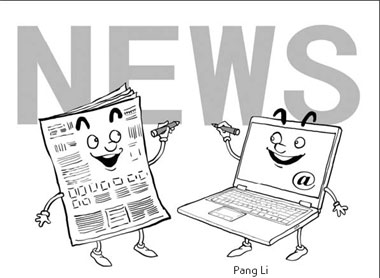Newspapers' response to the digital challenge
Updated: 2008-01-09 07:33
Newspapers are playing a game of digital leapfrog. One paper does not merely catch up when another jumps ahead. It usually overtakes by taking advantage of technological developments its rival was unable to embrace. There is no possibility of standing still. What is state-of-the-art today will be old hat by tomorrow.
In a sense, the online revolution is like a train journey without a destination. As soon as one paper arrives at a station that had once appeared to be a terminus, another title has built a new line and sped onward.
Despite the differences, everyone seems clear about the general direction to take toward an otherwise mysterious objective: the future of news gathering and news delivery is tied to the screen.

For the moment, given the need to keep on printing while simultaneously uploading, it means driving as fast as possible toward a brave new world while keeping the engines running at full power in the old - but still lucrative and popular - world of newsprint.
Inevitably, this split has proved uncomfortable, both in journalistic terms and, seen from the perspective of owners and managers, in financial terms too.
In company with editors, they have set the course to reach a single station named "integration". It is now clear that the days of binary staffing, with journalists for print and journalists for Web, are virtually over. In most offices the initial skepticism about the utility and viability of online news has long since passed.
In the United Kingdom, regional newspapers, as so often, have been in the forefront of this cultural change. Their reporters and subeditors have been embracing multi-platform journalism for several years. The national press in Britain has been slower off the mark, but they are forging ahead now.
Editors, naturally enough, tend to justify the merging of print and digital staff by talking of the journalistic imperative. But they are aware that there has been a commercial impulse too. With falling revenues from both circulation and advertising, it does not make financial sense to employ two sets of overlapping staff.
A similar, if somewhat controversial, financial logic has also dictated a reconsideration of the staffing requirements across seven days. Some dailies with Sunday counterparts have come to the conclusion that it is no longer feasible to have completely separate staff.
One of digital transmission's greatest benefits is that it allows for the merging of staff on daily and Sunday titles in a way that proved unachievable 20 years ago. Some call it another wonder of the Web; others call it job cuts under a digital cloak.
But integration is about much more than internal office structures. It is really about the creation of a new journalistic culture, a method of working that reflects both the technological possibilities and the demands of a wised up, increasingly media-savvy public.
Indeed, it is also about the response to a new public because newspapers are no longer serving a geographically distinct area. Worldwide access to news sites means that the audience served by London-based national newspapers, for example, is no longer merely British.
The challenge is to provide 24/7 news, to offer a minute-by-minute, round-the-clock news service. This can only be achieved through integration, by journalists responding to the demand of filing for website and the paper, by them bringing into play audio and video material whenever relevant.
One persistent criticism by skeptics is that journalists are being asked to do too much. Again, that's not what I discovered. As far as I could ascertain, journalists are grasping the opportunities offered by online publishing to write more freely.
There is much more fulfillment involved in writing a developing story when you discover that there is no longer any need to cut it to ribbons to fit a space. Updating for newsprint editions tended to be dispiriting because some material would inevitably be lost. Now it can be accommodated without any loss of detail.
It is true that on some papers, such as the Daily Telegraph, it took some prompting to encourage people to write regular blog contributions. Now that's not a problem. Journalists are seeing the value of the online medium even as they continue to delight in their newsprint bylines.
Finally, it is also clear that integration has stimulated journalists to become inventive. Once, it was the journalist geeks among us who had to goad reluctant colleagues to change their attitudes, to learn the new way of doing things.
Now journalists are realizing that integration is not only proving much less painless than expected, it is releasing them from the straitjacket of the single 24-hour deadline.
The Guardian
(China Daily 01/09/2008 page9)
|
|
|
|
|
|